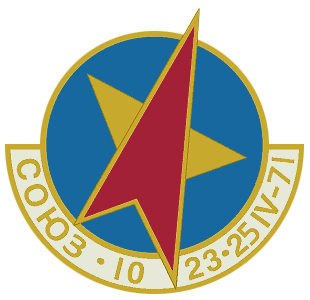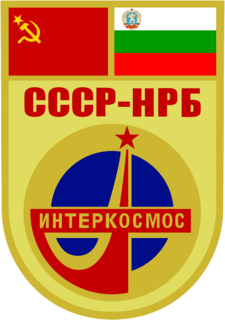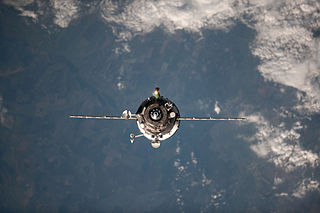
The Salyut programme was the first space station programme, undertaken by the Soviet Union. It involved a series of four crewed scientific research space stations and two crewed military reconnaissance space stations over a period of 15 years, from 1971 to 1986. Two other Salyut launches failed. In one respect, Salyut had the task of carrying out long-term research into the problems of living in space and a variety of astronomical, biological and Earth-resources experiments, and on the other hand the USSR used this civilian programme as a cover for the highly secretive military Almaz stations, which flew under the Salyut designation. Salyut 1, the first station in the programme, became the world's first crewed space station.

Soyuz is a series of spacecraft which has been in service since the 1960s, having made more than 140 flights. It was designed for the Soviet space program by the Korolev Design Bureau. The Soyuz succeeded the Voskhod spacecraft and was originally built as part of the Soviet crewed lunar programs. It is launched on a Soyuz rocket from the Baikonur Cosmodrome in Kazakhstan. Between the 2011 retirement of the Space Shuttle and the 2020 demo flight of SpaceX Crew Dragon, the Soyuz served as the only means to ferry crew to or from the International Space Station, for which it remains heavily used. Although China did launch crewed Shenzhou flights during this time, none of them docked with the ISS.

Soyuz 10 was launched on 22 April 1971 as the world's first mission to the world's first space station, the Soviet Salyut 1. The docking was not successful and the crew, Vladimir Shatalov, Aleksei Yeliseyev, and Nikolai Rukavishnikov, returned to Earth without having entered the station. It would be the first of numerous docking failures in the Soviet space station program.

Salyut 1 (DOS-1) was the world's first space station launched into low Earth orbit by the Soviet Union on April 19, 1971. The Salyut program followed this with five more successful launches of seven more stations. The final module of the program, Zvezda (DOS-8), became the core of the Russian segment of the International Space Station and remains in orbit.

Salyut 3 was a Soviet space station launched on 25 June 1974. It was the second Almaz military space station, and the first such station to be launched successfully. It was included in the Salyut program to disguise its true military nature. Due to the military nature of the station, the Soviet Union was reluctant to release information about its design, and about the missions relating to the station.

Salyut 5, also known as OPS-3, was a Soviet space station. Launched in 1976 as part of the Salyut programme, it was the third and last Almaz space station to be launched for the Soviet military. Two Soyuz missions visited the station, each manned by two cosmonauts. A third Soyuz mission attempted to visit the station, but failed to dock, whilst a fourth mission was planned but never launched.

Soyuz 29 was a 1978 crewed Soviet space mission to the Salyut 6 space station. It was the fifth mission, the fourth successful docking, and the second long-duration crew for the orbiting station. Commander Vladimir Kovalyonok and flight engineer Aleksandr Ivanchenkov established a new space-endurance record of 139 days.

Gennady Mikhailovich Strekalov was an engineer, cosmonaut, and administrator at Russian aerospace firm RSC Energia. He flew into space five times and lived aboard the Salyut 6, Salyut 7, and Mir space stations, spending over 268 days in space. The catastrophic explosion of a Soyuz rocket in 1983 led to him being one of only four people to use a launch escape system. He was decorated twice as Hero of the Soviet Union and received the Ashoka Chakra from India.

Vladimir Georgiyevich Titov is a retired Russian Air Force Colonel and former cosmonaut. He has participated in four spaceflight missions. The catastrophic explosion of a Soyuz rocket in 1983 led to him being one of only four people to use a launch escape system. He is married to Alexandra Kozlova, they have two children.

Soyuz 33 was an April, 1979, Soviet crewed space flight to the Salyut 6 space station. It was the ninth mission to the orbiting facility, but an engine failure forced the mission to be aborted, and the crew had to return to Earth before docking with the station. It was the first failure of a Soyuz engine during orbital operations.
Soyuz T-13 was a Soyuz mission, transporting personnel to the Soviet space station Salyut 7. The eighth expedition to the orbital station, the mission launched from Baikonur Cosmodrome, atop a Soyuz-U2 carrier rocket, at 06:39:52 UTC on June 6, 1985. It is of note because it marked the first time a spacecraft had docked with a 'dead' space station, and the first time such a station had been returned to operational status following repairs.

A space rendezvous is a set of orbital maneuvers during which two spacecraft, one of which is often a space station, arrive at the same orbit and approach to a very close distance. Rendezvous requires a precise match of the orbital velocities and position vectors of the two spacecraft, allowing them to remain at a constant distance through orbital station-keeping. Rendezvous may or may not be followed by docking or berthing, procedures which bring the spacecraft into physical contact and create a link between them.

Kurs is a radio control system used by the Soviet and later Russian space program.

Soyuz 7K-OK was the first generation of Soyuz spacecraft and was flown between 1967 and 1971. The 7K-OK was used for the first ferry flights to the Salyut space station program, beginning a long history of space station service that continues today with the International Space Station (ISS).

Soyuz TMA-07M was a spaceflight launched to the International Space Station in 2012 which transported three members of the Expedition 34 crew to the station. The Soyuz remained docked to the space station and served as an emergency escape vehicle for the Expedition 35 increment, before returning its crew to Earth in May 2013.
Salyut 6 EO-1 was a Soviet long duration space expedition, the first to dock successfully with the space station Salyut 6. The two person crew stayed were in space for a record setting 96 days, from December 1977 to March 1978. The expedition was the start of what would be the semi-permanent occupation of space by the Soviets.

Docking and berthing of spacecraft is the joining of two space vehicles. This connection can be temporary, or partially permanent such as for space station modules.

Progress M-15M, identified by NASA as Progress 47P, is a Progress spacecraft used by Roskosmos to resupply the International Space Station during 2012. The fifteenth Progress-M 11F615A60 spacecraft, it has the serial number 415 and was built by RKK Energia. It arrived at the ISS in late April to deliver supplies to the Expedition 30 crew, and departed the ISS in late July 2012.

Progress M-19M, identified by NASA as Progress 51P, is a Progress spacecraft used by Roskosmos to resupply the International Space Station during 2013. Progress M-19M was launched on a standard 2-day rendezvous profile towards the ISS. The 19th Progress-M 11F615A60 spacecraft to be launched, it had the serial number 419 and was built by RKK Energia.

Progress MS-01, identified by NASA as Progress 62P was a Progress spaceflight operated by Roscosmos to resupply the International Space Station (ISS) in 2015. It was launched on 21 December 2015, to deliver cargo to the ISS. Progress MS-01 is the first vehicle in the Progress-MS series.
















